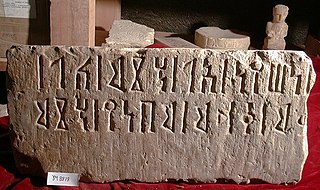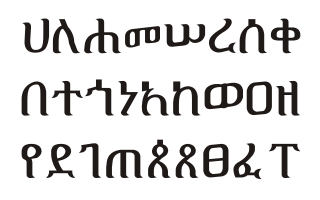
The Arabic alphabet, or Arabic abjad, is the Arabic script as specifically codified for writing the Arabic language. It is written from right-to-left in a cursive style, and includes 28 letters, of which most have contextual letterforms. The Arabic alphabet is considered an abjad, with only consonants required to be written; due to its optional use of diacritics to notate vowels, it is considered an impure abjad.

The Sinhala script, also known as Sinhalese script, is a writing system used by the Sinhalese people and most Sri Lankans in Sri Lanka and elsewhere to write the Sinhala language as well as the liturgical languages Pali and Sanskrit. The Sinhalese Akṣara Mālāva, one of the Brahmic scripts, is a descendant of the Ancient Indian Brahmi script. It is also related to the Grantha script.
The Coptic script is the script used for writing the Coptic language, the latest stage of Egyptian. The repertoire of glyphs is based on the uncial Greek alphabet, augmented by letters borrowed from the Egyptian Demotic. It was the first alphabetic script used for the Egyptian language. There are several Coptic alphabets, as the script varies greatly among the various dialects and eras of the Coptic language.
Thaana, Tãnaa, Taana or Tāna is the present writing system of the Maldivian language spoken in the Maldives. Thaana has characteristics of both an abugida and a true alphabet, with consonants derived from indigenous and Arabic numerals, and vowels derived from the vowel diacritics of the Arabic abjad. Maldivian orthography in Thaana is largely phonemic.

Malayalam script is a Brahmic script used commonly to write Malayalam, which is the principal language of Kerala, India, spoken by 45 million people in the world. It is a Dravidian language spoken in the Indian state of Kerala and the union territories of Lakshadweep and Puducherry by the Malayali people. It is one of the official scripts of the Indian Republic. Malayalam script is also widely used for writing Sanskrit texts in Kerala.
Greek numerals, also known as Ionic, Ionian, Milesian, or Alexandrian numerals, are a system of writing numbers using the letters of the Greek alphabet. In modern Greece, they are still used for ordinal numbers and in contexts similar to those in which Roman numerals are still used in the Western world. For ordinary cardinal numbers, however, modern Greece uses Arabic numerals.

The Early Cyrillic alphabet, also called classical Cyrillic or paleo-Cyrillic, is an alphabetic writing system that was developed in Medieval Bulgaria in the Preslav Literary School during the late 9th century. It is used to write the Church Slavonic language, and was historically used for its ancestor, Old Church Slavonic. It was also used for other languages, but between the 18th and 20th centuries was mostly replaced by the modern Cyrillic script, which is used for some Slavic languages, and for East European and Asian languages that have experienced a great amount of Russian cultural influence.

The Tamil script is an abugida script that is used by Tamils and Tamil speakers in India, Sri Lanka, Malaysia, Singapore, Indonesia and elsewhere to write the Tamil language. It is one of the official scripts of the Indian Republic. Certain minority languages such as Saurashtra, Badaga, Irula and Paniya are also written in the Tamil script.
Khmer script is an abugida (alphasyllabary) script used to write the Khmer language, the official language of Cambodia. It is also used to write Pali in the Buddhist liturgy of Cambodia and Thailand.
The Greek alphabet has been used to write the Greek language since the late 9th or early 8th century BC. It is derived from the earlier Phoenician alphabet, and was the earliest known alphabetic script to have distinct letters for vowels as well as consonants. In Archaic and early Classical times, the Greek alphabet existed in many local variants, but, by the end of the 4th century BC, the Euclidean alphabet, with 24 letters, ordered from alpha to omega, had become standard and it is this version that is still used for Greek writing today.

The Persian alphabet, also known as the Perso-Arabic script, is the right-to-left alphabet used for the Persian language. It is a variation of the Arabic alphabet with four additional letters: پ چ ژ گ. It was the basis of many Arabic-based scripts used in Central and South Asia. It is used for the Iranian and Dari standard varieties of Persian; and is one of two official writing systems for the Persian language, alongside the Cyrillic-based Tajik alphabet.

The Ancient South Arabian script branched from the Proto-Sinaitic script in about the late 2nd millennium BCE. It was used for writing the Old South Arabian languages Sabaic, Qatabanic, Hadramautic, Minaean, and Hasaitic, and the ancient language of Eritrea, Geʽez in Dʿmt. The earliest instances of the Ancient South Arabian script are painted pottery sherds from Raybun in Hadhramaut in Yemen, which are dated to the late 2nd millennium BCE. There are no letters for vowels, which are marked by matres lectionis.

Pahlavi is a particular, exclusively written form of various Middle Iranian languages. The essential characteristics of Pahlavi are:

Geʽez is a script used as an abugida (alphasyllabary) for several Afro-Asiatic and Nilo-Saharan languages of Ethiopia and Eritrea. It originated as an abjad and was first used to write the Geʽez language, now the liturgical language of the Ethiopian Orthodox Tewahedo Church, the Eritrean Orthodox Tewahedo Church, the Eritrean Catholic Church, the Ethiopian Catholic Church, and Haymanot Judaism of the Beta Israel Jewish community in Ethiopia. In the languages Amharic and Tigrinya, the script is often called fidäl (ፊደል), meaning "script" or "letter". Under the Unicode Standard and ISO 15924, it is defined as Ethiopic text.
A numeral is a character that denotes a number. The decimal number digits 0–9 are used widely in various writing systems throughout the world, however the graphemes representing the decimal digits differ widely. Therefore Unicode includes 22 different sets of graphemes for the decimal digits, and also various decimal points, thousands separators, negative signs, etc. Unicode also includes several non-decimal numerals such as Aegean numerals, Roman numerals, counting rod numerals, Mayan numerals, Cuneiform numerals and ancient Greek numerals. There is also a large number of typographical variations of the Western Arabic numerals provided for specialized mathematical use and for compatibility with earlier character sets, such as ² or ②, and composite characters such as ½.
Many scripts in Unicode, such as Arabic, have special orthographic rules that require certain combinations of letterforms to be combined into special ligature forms. In English, the common ampersand (&) developed from a ligature in which the handwritten Latin letters e and t were combined. The rules governing ligature formation in Arabic can be quite complex, requiring special script-shaping technologies such as the Arabic Calligraphic Engine by Thomas Milo's DecoType.
In the Unicode standard, a plane is a continuous group of 65,536 (216) code points. There are 17 planes, identified by the numbers 0 to 16, which corresponds with the possible values 00–1016 of the first two positions in six position hexadecimal format (U+hhhhhh). Plane 0 is the Basic Multilingual Plane (BMP), which contains most commonly used characters. The higher planes 1 through 16 are called "supplementary planes". The last code point in Unicode is the last code point in plane 16, U+10FFFF. As of Unicode version 15.1, five of the planes have assigned code points (characters), and seven are named.

Inscriptional Pahlavi is the earliest attested form of Pahlavi scripts, and is evident in clay fragments that have been dated to the reign of Mithridates I. Other early evidence includes the Pahlavi inscriptions of Parthian coins and rock inscriptions of Sasanian emperors and other notables, such as Kartir the High Priest.
Psalter Pahlavi is a cursive abjad that was used for writing Middle Persian on paper; it is thus described as one of the Pahlavi scripts. It was written right to left, usually with spaces between words.











